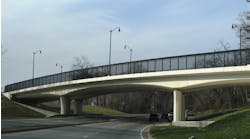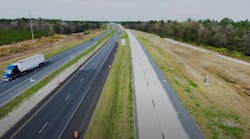Mechanically stabilized earth walls, or MSE walls, are commonly used to stabilize backfill around bridges or for retaining walls along freeways. In the last 15 years, UDOT’s use of MSE walls has become routine where retaining walls are required.
UDOT has a database of over 700 MSE walls in use across the state-owned transportation system. The walls are “a valuable asset,” said Chief Geotechnical Engineer Keith Brown. “We need to maintain walls the best way we can.”
UDOT partnered with Assistant Professor Dr. Travis Gerber, P.E., from the Brigham Young University Civil and Environmental Engineering Department, and his team of researchers to assess corrosion on steel reinforcement used in MSE walls in Salt Lake County, Utah. The results of the study will help UDOT engineers determine better ways to design, build and care for MSE walls which are critically important features of Utah’s transportation system. The main objective of the study was to “take an initial look at the walls and to see how they’re holding up,” said Brown, by viewing steel-wire “coupons” designed to be removed from MSE walls. “From that baseline look, we can see which walls need attention” due to design, drainage, materials or environmental factors.
Staging it out
Retaining walls can be good solutions where widening roadway embankments might otherwise involve right-of-way issues that are expensive and/or difficult to resolve. Use of MSE retaining walls has increased over the past decade compared to cantilever or gravity-type walls because of performance and budgetary advantages:
- MSE walls can better tolerate foundation settlement without adverse problems;
- Although MSE construction is more labor intensive, cost savings are realized since cost for formwork for traditional concrete walls increases dramatically with increased wall height; and
- Inconvenience to the public is less because the wall construction schedule is shortened with use of precast MSE wall elements.
-
MSE walls are built in lifts or layers of fill with steel or geosynthetic reinforcement installed as required by the wall design. In the recent UDOT study conducted by Gerber, galvanized steel reinforcement material was examined from two types of MSE walls –one stage and two stage. One-stage MSE walls are built using a concrete panel or block wall facing materials to retain the reinforced backfill. The facing materials are anchored using welded galvanized steel wire mesh, steel straps or geosynthetic grids embedded in the retained back fill. Two-stage walls are often used where large settlements are expected. The construction is similar; walls are built using welded wire-mesh panels along with geosynthetic fabric facing, instead of concrete facing panels, to retain backfill. After expected settlement takes place, concrete-facing panels are attached. Culprits of corrosion The useful life of an MSE wall is expected to be at least 75 years. A brief statement from the study report points out the importance of MSE wall design, construction and maintenance: “Successful performance of MSE walls depends on the integrity of the internal reinforcement.” Some basic requirements must be met in order to realize that expected useful life, including design that provides for good drainage, the right material choices and inspection during the construction process. When it comes to corrosion, the two most common culprits are low-quality backfill and inadequate drainage. Backfill that is too acidic or alkaline accelerates corrosion and can ultimately lead to premature failure of an MSE wall. Before construction, backfill should be tested for soil resistivity, pH and salt content to ensure that high-quality material is used. Inadequate drainage also can lead to failure since fluctuating water tables can accelerate corrosion. Other culprits include air that passes through and/or remains in the backfill and intruding salts from deicing along roadways. Taking a good look Extractable steel-wire coupons allowed the study team to conduct “an actual physical inspection,” said Gerber. Other methods measure changes in electrical resistivity to assess the condition of coupons in place. “It’s more accurate to actually see and measure” the removable coupons. UDOT reconstructed I-15 in Salt Lake County in preparation for the 2002 Olympics. Construction contractors were required to insert steel-wire coupons that could eventually be removed and examined. Steel-wire coupons were required to be 3?8-in. diameter and 6 to 10 ft long with a threaded end to facilitate removal through a hole in the face of the MSE concrete panel or block wall. All coupons were required to be made of galvanized steel—the same material used to fabricate the wire-mesh reinforcement used in MSE walls. Galvanization, which applies zinc to steel, improves the corrosion resistance of steel; zinc corrodes more slowly than steel and therefore delays the eventual corrosion of steel. The byproduct of zinc corrosion also forms a protective barrier, which further slows the corrosion of steel. MSE wall designers require steel reinforcement of a large enough cross-sectional area to assure that a proper amount of steel is intact at the end of MSE wall life after some expected corrosion takes place. Before the extraction process, the study team examined project files to find information about the original size and weight of the coupons. Team members also questioned engineers that were involved in the original reconstruction process to uncover helpful anecdotal information. Gerber’s team identified 26 coupon locations along I-15 from a GIS database of MSE walls. The MSE-wall database had been created as part of another research project, which involved a multiuniversity team. Next, study team members visited MSE wall locations to view and document possible problem areas that might indicate environmental or design issues that could lead to corrosion. For example, since water can cause corrosion of the wire mesh, study team members looked for evidence of poor drainage—like erosion of backfill through joints or pooled water. To remove coupons, Gerber’s study team used two 12-in. stroke hydraulic jacks. The jacks were attached to a portable wood frame designed to distribute load across the MSE-wall-facing panels. The device was light enough to be carried to remote sites without vehicular access. With the frame mounted against the wall, the tandem jacks were connected to the coupon with a threaded rod and coupler. The coupons were pulled out when pistons were extended and pipe spacers were used to extract more of the coupon as needed. Twenty-two coupons were removed and examined. All coupons were extracted within 6 ft of existing grade, avoiding the necessity of equipment such as a lift truck or man-basket. For the better Field observations revealed the galvanization on coupons to be largely intact with a variable amount of white oxidation visible on the surface. In a few instances, the galvanization had flaked off where the coupons appeared to have been damaged during the construction or galvanization process. The amount of steel corrosion as evidenced by red rust was minimal. This observation shows the importance of doing on-site inspection during construction before the material is placed as reinforcement in MSE walls. At the two-stage wall sites, study team members could view the vertical wire mesh through the holes used to extract the coupons. Corrosion on the wire mesh seemed to match the observed corrosion on the coupons. Laboratory measurements showed that the average thickness of galvanization on all coupons presently exceeds standards required at the time of installation. Designers of the I-15 reconstruction “apparently attributed ‘no useful life’ to the galvanization and accommodations for corrosion was incorporated into the sacrificial steel thickness,” according to the study report. Even though the study team was not able to ascertain the original thickness of galvanization and hence establish a current corrosion rate, it does appear that failure due to corrosion is very unlikely during the expected life of the MSE walls. Gerber’s team, with UDOT oversight, was successful at establishing a critical baseline index of the condition of steel reinforcements used in MSE walls along I-15 through Salt Lake County. Because the study involved actual physical inspection, data from the study is accurate and reliable. In addition, Gerber believed that study conclusions can apply to other nearby locations. “We think you can extrapolate the results.” As long as soils, backfill specifications and environmental area are similar, “the performance should be similar.” The conclusions from this study will eventually contribute to better design choices, appropriate material use and effective long-term maintenance standards and practices.


